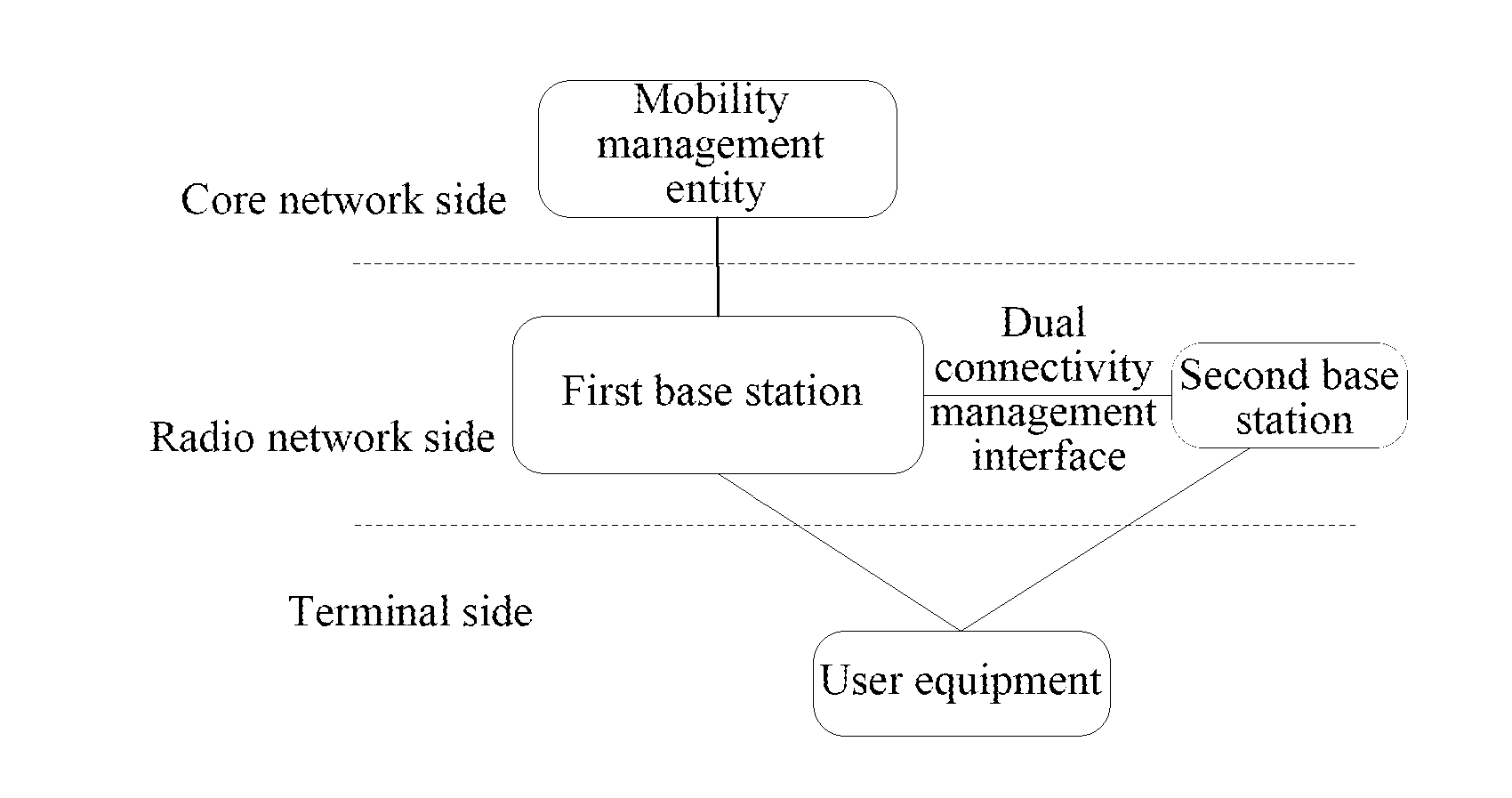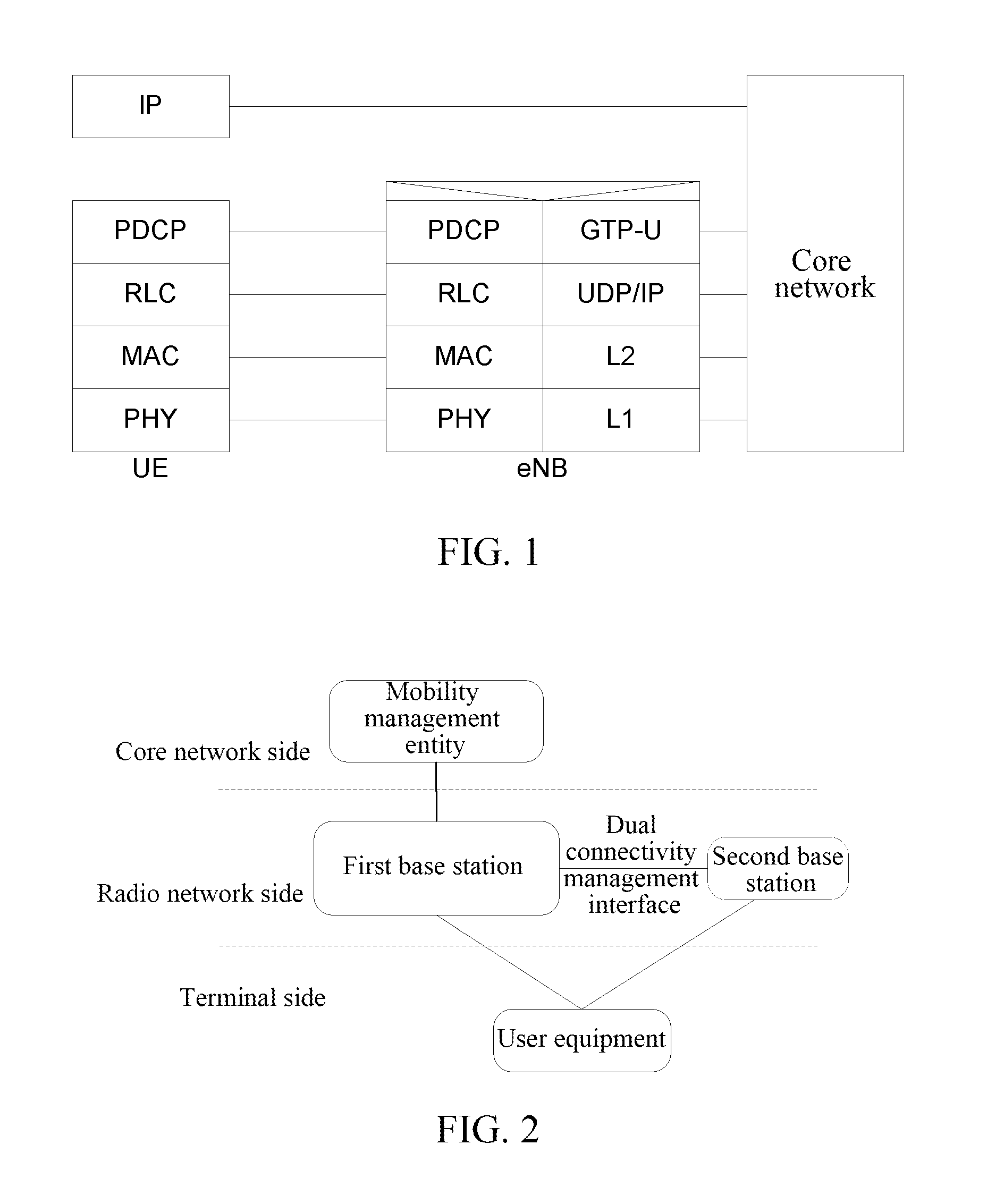Double-Connection Implementation Method and Base Station
a dual connection and implementation method technology, applied in data switching networks, instruments, frequency-division multiplexes, etc., can solve the problems of increasing user terminals, network deployment environment becoming more complex, and user experience reducing, so as to ensure backward compatibility of the network, improve the performance and user experience of the user data service, and reduce the impact of control plane signaling to the network
- Summary
- Abstract
- Description
- Claims
- Application Information
AI Technical Summary
Benefits of technology
Problems solved by technology
Method used
Image
Examples
first application example
[0056]As shown in FIG. 5, there are Macro and Pico in the deployed network, wherein the UE has the service connection bearer in the first base station, that is the Macro, wherein the network-side Access Stratum and Non-Access Stratum control planes are respectively ended in the Macro and the MME, and the Macro-side user plane is ended in the core network gateway (S / P-GW). The present embodiment is described by taking the method of adding a connection of the UE in the second base station (that is, the Pico base station) as well as establishing the UE context for example, comprising the following steps:
[0057]in step 1, the Macro sends a handover request to the Pico, and the request carries information of the connection bearer which needs to be established in the Pico. Because the UE did not have a connection in the Pico previously, the context information of UE also needs to be carried in the handover request. In the step, the existing S1 interface signaling can be multiplexed for imp...
second application example
[0070]As shown in FIG. 6, there are Macro and Pico in the deployed network, and the UE has dual connectivity in the Macro and the Pico, wherein the UE only has the user plane connection in the Pico, wherein the network-side Access Stratum and Non-Access Stratum control planes are respectively ended in the Macro and the MME, and the core network user plane node is the core network gateway. The present embodiment is described by taking the method of adding a connection of the UE in the second base station, that is, the Pico base station, for example, comprising the following steps:
[0071]in step 601, the MME sends an ERAB establishment request message to the Macro, and the request message carries the ERAB information to be established.
[0072]In step 602, after receiving the message, the Macro decides to establish the newly established ERAB into the Pico according to the load information of the present base station as well as the Pico base station, or according to other established algor...
third application example
[0088]As shown in FIG. 7, there are Macro and Pico in the deployed network, and the UE has the dual connectivity in the Macro and the Pico, and it has the control plane and user plane connections in both nodes, wherein the network-side Access Stratum and Non-Access Stratum control planes are respectively ended in the Macro and the MME, and the core network user plane node is the core network gateway. The present embodiment is described by taking the method of releasing the connection of the UE in the second base station, that is, the Pico base station, for example, comprising the following steps:
[0089]in step 701, the MME sends an ERAB release command message to the Macro, wherein the message carries the ERAB information to be released.
[0090]in step 702, after receiving the abovementioned message, the Macro determines that the connection corresponding to the to-be-released ERAB exists in the Pico, thus the Macro forwards an ERAB release command message to the Pico, wherein the ERAB ...
PUM
 Login to View More
Login to View More Abstract
Description
Claims
Application Information
 Login to View More
Login to View More - R&D
- Intellectual Property
- Life Sciences
- Materials
- Tech Scout
- Unparalleled Data Quality
- Higher Quality Content
- 60% Fewer Hallucinations
Browse by: Latest US Patents, China's latest patents, Technical Efficacy Thesaurus, Application Domain, Technology Topic, Popular Technical Reports.
© 2025 PatSnap. All rights reserved.Legal|Privacy policy|Modern Slavery Act Transparency Statement|Sitemap|About US| Contact US: help@patsnap.com



